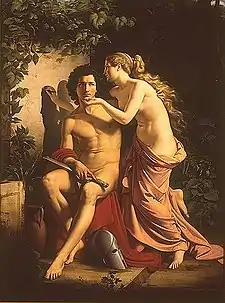Eduard Daege
Eduard Wilhelm Daege (10 April 1805, in Berlin – 6 June 1883, in Berlin) was a German painter who served as Director for both the Prussian Academy of Art and the National Gallery.[1]


Life
In 1820, he entered the Prussian Academy of Art, where he studied under Johann Gottfried Niedlich and later (in 1823) with the Court Painter Karl Wilhelm Wach.[1] In 1821, he may have been involved in painting the frescoes for Karl Friedrich Schinkel's Schauspielhaus at the Gendarmenmarkt. From 1832 to 1833, he accompanied Karl Eduard Biermann on a study trip to Rome and Naples.
He became a member of the Academy in 1835 and, beginning in 1838, taught drawing classes there. In 1840, he was appointed a Professor. He participated in painting the murals at the Neues Museum and in the chapel at the Berliner Stadtschlosses. From 1861 to 1874, he was Director of the Academy, a position which included managing the newly founded National Gallery.
Major works
- 1846–52: Geburt Christi (The Nativity), Anbetung der Hirten (Adoration of the Shepherds) and twenty-four assorted angel figures/heads at the Stadtschlosses.
- 1847–55: Rome, Jerusalem, Constantinople and Aachen, allegorical murals in the north dome-hall of the Neues Museum.
- 1856: Altarpiece in the convent at the monastery in Ribnitz-Damgarten.
References
- Bryan's Dictionary of Painters and Engravers, ed. by Michael Bryan and George Williamson. G. Bell & Sons, 1903.
Further reading
- Allgemeines Künstlerlexikon : die bildenden Künstler aller Zeiten und Völker. K. G. Saur, Munich 1992, Vol.23.